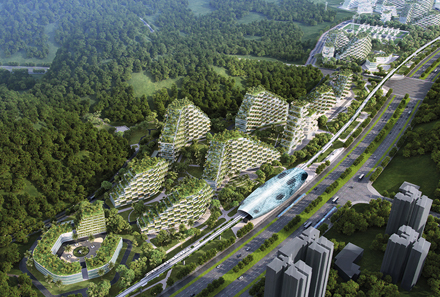
The smog levels in the southern Chinese city of Liuzhou are not yet dire but if the city fails to deal with its pollution, it will only get worse over time. Source: Business Insider
Italian design firm Stefano Boeri Architetti believes that building a neighborhood with plant-covered towers could help the city reduce its pollution levels. On June 26, Liuzhou broke ground on what Boeri calls a “forest city.”
In April, the company also announced that it will build two skyscrapers, called Nanjing Green Towers, that will hold a total of 1100 trees and 2500 cascading shrubs on their rooftops and balconies. The design will be similar to that of a two tower complex that Boeri designed in Milan. Another tower in Lausanne, Switzerland will follow a similar plan and is expected to open by early 2018.
Boeri’s ultimate goal is to create an entire forest city that will become a reality in Liuzhou by 2020. Take a look at the plans below.
The forest city will be constructed in the mountainous region of Liuzhou, China by 2020.
Commissioned by the Liuzhou Municipality Urban Planning department, the project calls for towers covered in 40,000 trees and nearly one million plants, drawn from over 100 species.
The plants will absorb an estimated 10,000 tons of CO2 and 57 tons of pollutants annually — which is the equivalent of kicking more than 2,100 cars off the road.
A small portion of the city, which has a total population of around 1.5 million residents, will be redeveloped. New offices, hotels, hospitals, schools, and homes for approximately 30,000 people will be built.
The majority of the buildings’ electricity will come from renewable sources, like solar power, according to the architects.
In early 2017, another Chinese city, Nanging, started building “forest towers” designed by Boeri. Set to be complete by 2018, they will feature offices, a 247-room luxury hotel, a museum, and an architecture school.
The Nanjing Green Towers will look similar to the two that Stefano Boeri Architetti designed in Milan, which measure 360 and 250 feet tall.
The balconies and rooftops are covered in approximately 900 trees and over 20,000 plants, ranging from shrubs to flowers.
On flat land, the plants from each tower would cover over 75,000 square feet, the architects said.
Collectively, the plants on Nanjing’s towers will eat 25 tons of carbon dioxide each year and produce about 60 kg of oxygen daily.
Though the two towers’ effect on Nanjing’s overall pollution levels will be minimal, they served as a blueprint for the forest city in Liuzhou.
Entire forest cities could collectively have a much larger impact on smog than individual towers.
Architect Stefano Boeri told The Guardian that forest cities could fundamentally alter China’s urban areas. Chinese officials, he said, “have created these nightmares – immense metropolitan environments. They have to imagine a new model of city that is not about extending and expanding but a system of small, green cities.”





